Fiber Arts Take Over a Former Seaport Warehouse in NYC
See waterfalls of fabric, intricate threadwork, massive tapestries, and more!


Common sense would urge you not to look down at the ground while navigating the crowded streets of New York City. But if you steal a glance every now and then, you may come across a fun discovery.
From 19th century clocks to art installations and celebrity handprints, here is a list of the most unique New York City sidewalk installations.
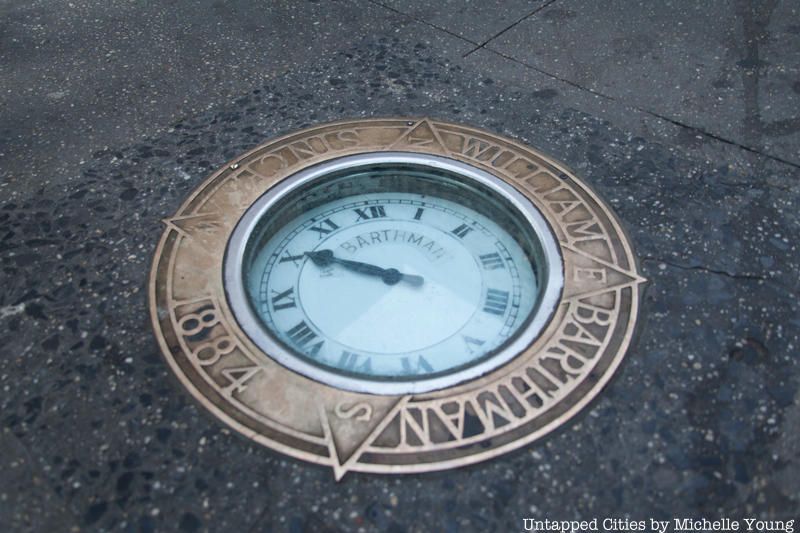
If you've lost track of time and happen to be on the corner of Maiden Lane and Broadway, leave your phone in your pocket and just look down at the clock in the sidewalk. A timepiece was placed there by New York City jeweler William Barthman in 1925. Barthman came up with the idea to put a clock in the sidewalk in front of his business to lure customers into the store, and it worked. The clock became an instantly famous New York City oddity. Over time, news of its existence even spread across the Atlantic and inspired an English jeweler to install one in front of his own Windsor storefront in 1949.
The original clock was installed in 1899 and was a modern marvel at the time. Barthman, along with his employee Frank Homm, designed a three-window jump hour clock that was illuminated at night by hidden lightbulbs and featured a technologically innovative battery backup. It took Barthman and Homm two years to design and build the clock, which proved to be so complicated that Homm was the only person who knew how to properly maintain it. When Homm died in 1917 the clock would often stop working, forcing the Barthman's to shamefully cover up the dysfunctional timepiece with a piece of cardboard.
In 1925, Barthman replaced his and Homm's design with a more traditional round faced clock. The only way to access the clock for repairs is from underneath the sidewalk in a small workspace. The room is only a few feet away from the subway network and is susceptible to shaking when the number 6 train goes by. According to one count, the clock is subjected to the pounding of approximately fifty thousand pedestrians' feet every three hours. Considering all the wear and tear it has to subjected to on a daily basis, it has tick away virtually nonstop for almost 100 years.
Since its founding, Barthman Jewellers has moved a few doors down from its original location on Broadway, but has remained on the same block for 130 years. A replica of the iconic Financial District timepiece was made for their new location but the New York government denied permission to put it underfoot, stating that there would only be one sidewalk clock in the city.
The Barthman clock has disappeared on multiple occasions over recent years. As of January 2025, there is no clock face installed.
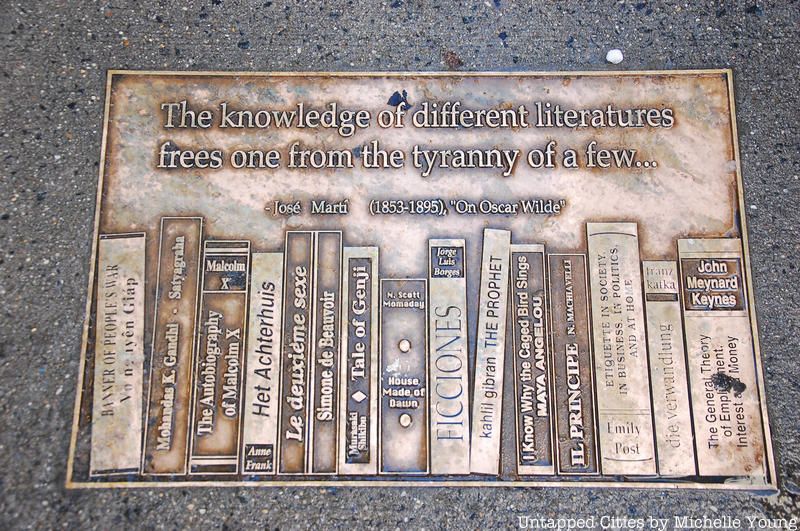
Walking down 41st street towards the Stephen A. Schwarzman Building of the New York Public library, pedestrians can get a sample of the literary treasures that await them before even entering the building. The two blocks between Park and 5th Avenue, dubbed Library Way in 2003 by legislation signed by New York City Mayor Michael R. Bloomberg, are lined with 32 intricately designed bronze plaques emblazoned with quotes from literary giants like Emily Dickinson, Gertrude Stein, William Butler Yeats, and Ernest Hemingway. The quotations were selected in 1996 by a distinguished panel of literary experts and librarians who chose excerpts from some of literature’s most prominent works that best represented the importance and impact of literature.
The plaques were created by sculptor Gregg LeFevre in 1998 and each feature a unique visual interpretation of the accompanying quote. They were made possible by a partnership between the Grand Central Partnership, the New York Public Library and property owners and commercial tenants along 41st street. The installation received the “Excellence in Design” award by the New York City Arts Commission in 1998.

In the 1910's New York City was taking over land downtown in order to extend 7th avenue and expand the IRT subway system. When all was said and done the city had acquired over 300 properties under eminent domain laws, but there were 500 square inches that they couldn't get their hands ons.
David Hess was the owner of the Voorhis apartment building on the corner of Christopher Street and 7th Avenue in Greenwich Village, and when that property was taken over by the city, he didn't give it up without a fight. Hess refused to relinquish ownership of a small plot of land measuring 500 square inches located on the plot of his former apartment building. On July 27, 1922 this slice of property was marked by a triangular mosaic of black and yellow tiles that reads "Property of the Hess Estate which has never been Dedicated for Public Purpose," obstinately declaring Hess's refusal to accept the City's request for the last vestige of his domain.
The mosaic, now cracked, can still be seen on the sidewalk outside of Village Cigars. The plot was sold to Village Cigars in 1938 for $1,000.
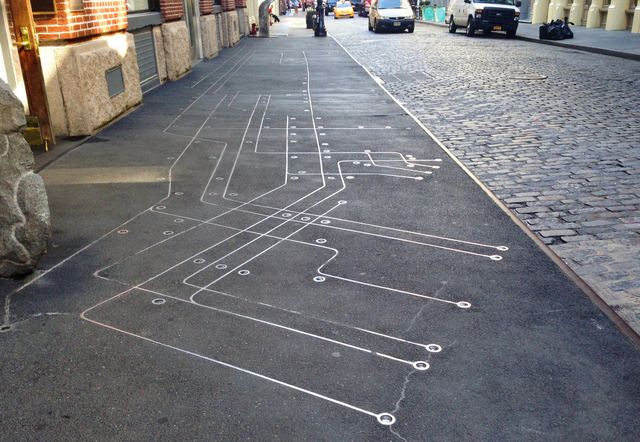
In front of 110 Greene Street, just south of Prince Street, the subway sits above ground thanks to Françoise Schein's Subway Map Floating on a New York City Sidewalk. Schein's floating subway is a permanent art installation that depicts the subway routes of 1985 Manhattan, the year the piece was installed. This sidewalk subway is made of stainless steel bars, terrazzo flooring, and hand-blown glass rounds with lights embedded into the ground. The map stretches 90 feet and includes all 156 stops that were part of the subway system in Manhattan at the time. The Belgian born artist said Brooklyn and Queens just didn't fit on the sidewalk.
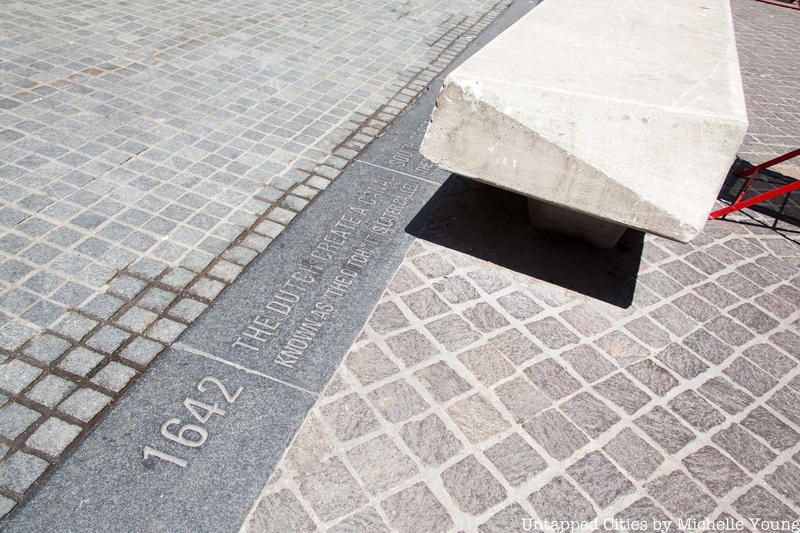
While designing the NYSE: Financial District Streetscapes+Security Project, Rogers Partners architects highlighted the history of the area while adding security for NYC pedestrians. The goal of the project, which was completed in partnership with the NYC Economic Development Corporation, the Department of City Planning and the Lower Manhattan Development Corporation, was to "enable a vibrant streetscape while providing cutting-edge security in one of New York’s densest urban conditions."
Part of the project included highlighting the former route of a canal that ran through downtown Manhattan in 1620 by marking its path with an engraved-granite curb that runs along Broad Street. The Heere Gracht, as the canal came to be named by Dutch settlers, flowed through New York when downtown Manhattan looked more like Amsterdam than the hub of modern finance that it is today. 17th century NYC stretched only from the southern tip of the island up to a defense wall that ran along, can you guess where? Wall Street! You can still see wooden block pavers embedded in the cobblestone streets that indicate the site of the former wall.

What do the New York Yankees, Charles Lindbergh and Haile Selassie, the Emperor of Ethiopia all have in common? They were all celebrated in New York City with a ticker tape parade and their parades are all commemorated by a granite plaque along the Canyon of Heroes. The Canyon of Heroes is the route travelled by parades down Broadway. Along that route from, Bowling Green to the Woolworth Building, there are 164 plaques that create a timeline of ticker tape parades from the dedication of the Statue of Liberty in 1886 to the United States Women's National Soccer Team Championship parade in 2015.
The plaques are made of 8 inch wide and 3 inch thick granite strips that resemble the strips of ticker tape paper thrown from the windows during parades. The strips are emblazoned with silver-leaf lettering that notes the date and honoree of each parade. The plaques were part of a $20 million streetscape project that also brought new sidewalks, lampposts, signs and wastebaskets to Broadway.

80 Saint Marks Place has hosted stars and scoundrels alike since the early 20th century. Before the arts took over and turned 80 Saint Marks into Theater 80, it was a speakeasy called Schieb's Place. Once prohibition ended, 80 Saint Marks debuted on the East Village arts scene as a jazz club where the likes of performers such as Thelonious Monk, Harry “Sweets” Edison, John Coltrane and Frank Sinatra took the stage. In the 1970s and 80s the venue became a film revival house that screened vintage films. The theater now offers a variety of productions, from Shakespearean plays to flamenco dancing, tours of the theater and is available for use community use.
Throughout the years many stars have left their mark on the theater, literally. On the sidewalk in front you'll find the worn down handprints and cement signatures of stars like Joan Crawford, Ruby Keeler, Winnie Shaw, Fifi D’Orsay and Joan Rivers, who recently added her name to this Manhattan walk of fame. When Paramount Studios offered to have the cement blocks shipped to Hollywood, the theater owners turned the movie giant down.
The theater is currently raising money via a Go Fund Me campaign in order to support its preservation and ongoing operation.
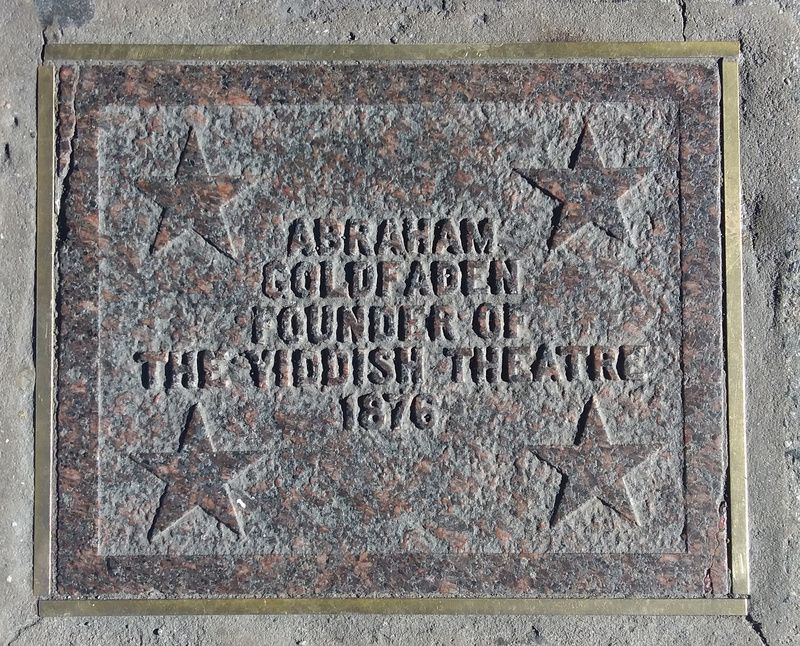
In the early 20th Century Second Avenue in the Lower East Side used to be known as "Yiddish Broadway." The area was rife with theaters that put on all kinds of plays in Yiddish. To keep that history alive Second Avenue Deli owner Abe Lebewohl installed the Yiddish Theatre Walk of Fame in 1984 on the sidewalk in front of his deli. Lebewohl's walk is made up of two rows of granite stars that feature the names of icons of the "Jewish Rialto" including Molly Picon, the Thomashevskys, The Barry Sisters, Fyvush Finkel, Moishe Oysher, Joseph Rumshinsky, Maurice Schwartz, 32 stars in all. The walk of fame is located down the block from one of the few physical remnants of this area's thriving Yiddish art scene, the Jaffe Yiddish Arts Theater, now Village East Cinema.
Lebewohl sadly passed away in 1996 and in 2007 The Second Avenue Deli moved uptown. Since then, the Walk of Fame has gone into disrepair. Thankfully, The Greenwich Village Society for Historic Preservation has created the Friends of the Abe Lebewohl Yiddish Theatre Walk of Fame along with Lebewohl's descendants and a coalition of neighborhood groups. The Friends hope to raise enough money to remove the original plaque tiles from the sidewalk and exhibit them as part of a permanent or traveling exhibition and then "commission a recreation of the original plaque tiles to be reinstalled somewhere relevant and nearby."
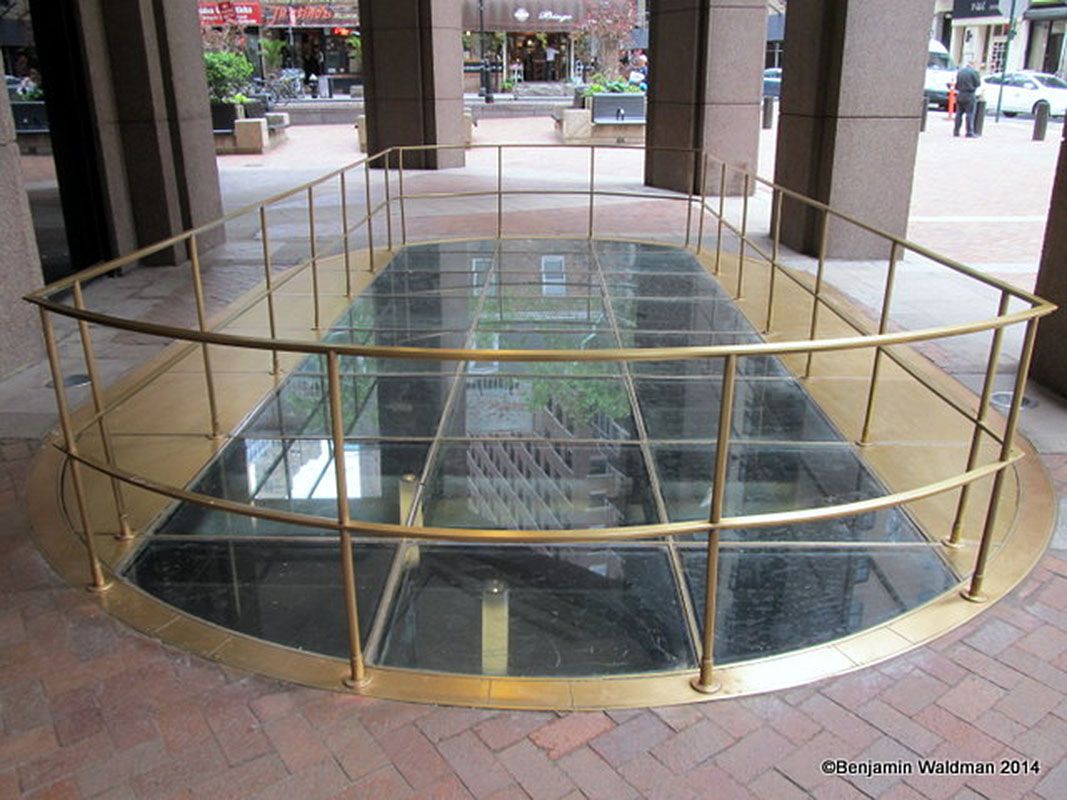
At 85 Broad Street part of New York's colonial past can be found peeking through the modern streets of the Financial District. Covered by glass and surrounded by brass railings you'll find the remnants of Governor Lovelace's Tavern. The tavern dates back to around 1670 and was uncovered during an excavation of the site in 1979. The establishment was owned by the governor at the time, Colonel Francis Lovelace. For a few years, the tavern function as a second city hall of sorts until a new city hall was built in 1700. Unfortunately, like most of the buildings from its time, the tavern burned down and eventually the land was taken over by the growing merchant district.
Today, passersby can still see the foundation walls of the former structure through a glass covered opening in the sidewalk. For another glimpse back at colonial New York, you'll only need to walk about 100 feet away to visit the historic Fraunces Tavern.
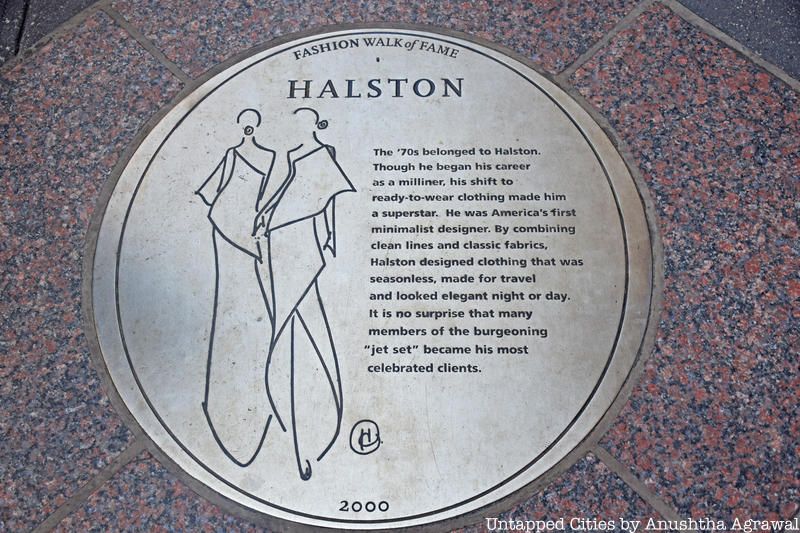
While you strut your stuff through the Garment District you'll be walking among the world's most influential fashion designers. On the east side of Seventh Avenue, from 35th to 41st street, near the Fashion Institute of Technology, there are 26 plaques that make up the Fashion Walk of Fame, each dedicated to a designer who "had a significant and lasting impact on the way the world dresses." Among those honored are Calvin Klein, Ralph Lauren, Oscar de La Renta and Betsey Johnson. The honorees were chosen by a group of 143 industry professionals.
The metal plaques,are 30 inches in diameter and framed with black granite. The plaques were installed over the course of three years and cost $200,000. Engraved on each piece is a sketch by the designer and a description of their contribution to the fashion world.

326 Spring Street, the historic Ear Inn, comfortably sits a block and a half back from the Hudson River. However, before 1825, the building sat only 5 feet from the rocky shoreline at the water's edge. Once the Erie Canal opened, making the Hudson River a integral trade route, the land in this area of Manhattan was extended with landfill to create docks and landings for ships that would unload goods onto Manhattan's shore and the shoreline was extended westward.
A plaque on the sidewalk commemorates the original shoreline of the river from 1766. This line wasn't crossed until 2012 when Hurricane Sandy brought the Hudson's waters almost a quarter mile inland, reaching almost to Hudson street.
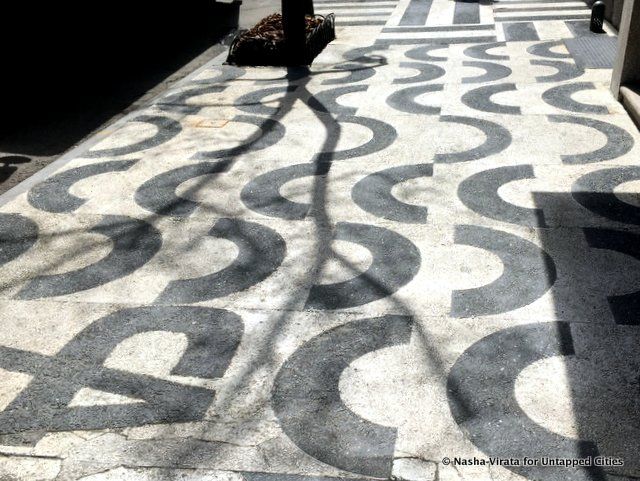
The sidewalk outside of 1014-1018 Madison Avenue between 78th and 79th streets is unlike any other in the city. Instead of the standard grey, dotted with petrified gum that you will find around most of the city, these sidewalks showcase a design by sculptor Alexander Calder. Calder is best known for his large-scale statue and mobile sculptures but was commissioned to design this project by the owners of the three buildings on the block, all of whom were gallerists.
The funky sidewalk features three distinct patterns made up of curves, straight lined squares and a sun-ray design made up of terrazzo. The tiles, which are made with marble chips and concrete, were created by the Foscato Bros. of Huntington, L. I., a company that employed elderly Italian Americans familiar with creating and working with terrazzo. Calder donated the design, but the construction costs came to $15,000 when it was complete in 1970.
The block was restored in 2002 with the support of the Calder Foundation and the New York City Landmarks Commission.
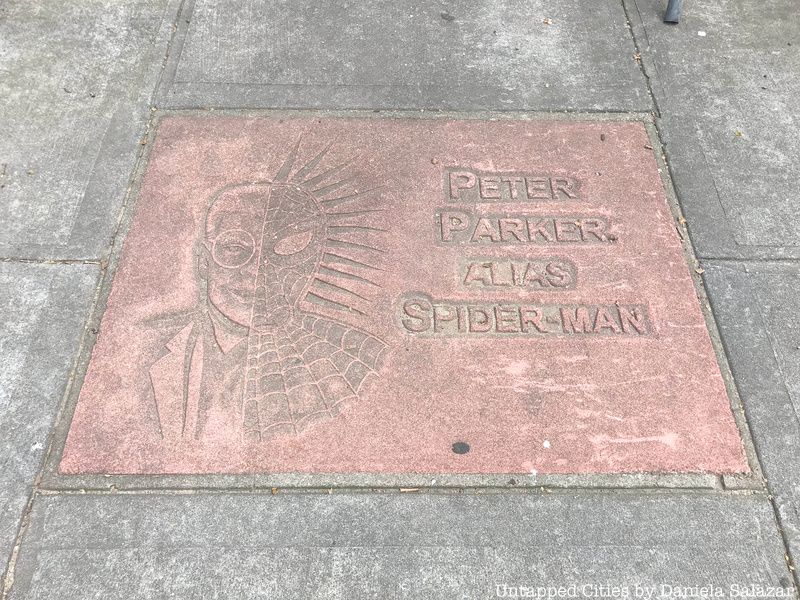
Peter’s Field, located between 20th and 21st Streets and First and Second Avenues, is named for two of the city’s most prominent historical figures, Peter Stuyvesant and Peter Cooper, but they share the limelight with a few other famous Peters in this park. During a renovation of the playground and tennis courts in 1998 a series of cast concrete plaques, placed in pairs along Second Avenue, were installed that depict other famous Peters such as children's story characters like Peter Pan, Peter Pumpkin Eater, Peter Rabbit and of course Peter Piper, picking pickled peppers. There is even a plaque for your friendly neighborhood Spiderman, Peter Parker.
Subscribe to our newsletter